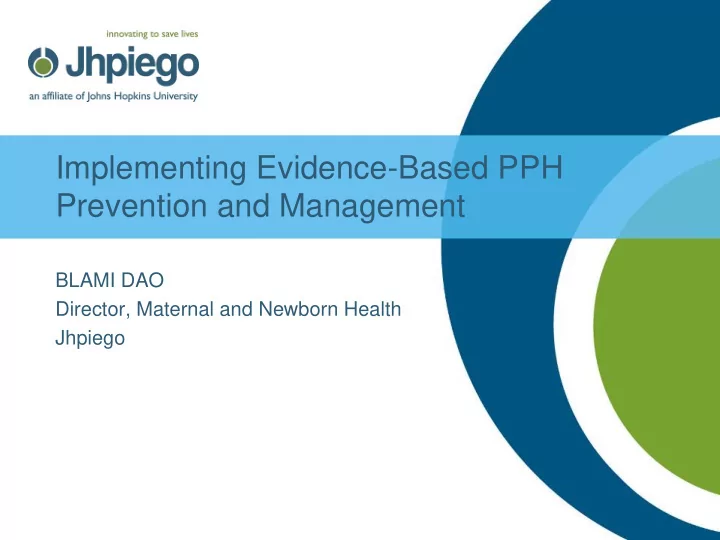

Implementing Evidence-Based PPH Prevention and Management BLAMI DAO Director, Maternal and Newborn Health Jhpiego
Introduction � Existence of PPH prevention and treatment solutions � However, every year 14,000 women died from PPH � Main reason: Lack of implementation of these solutions 2
Clinical Interventions � Basic EmOC � Management of shock � Uterotonics � Bimanual compression � Suturing of lacerations � Aortic compression � Manual removal of placenta � Comprehensive EmOC � Uterine artery ligation � B-lynch procedure � Hysterectomy � Blood transfusion 3
The Evidence for the Treatment of PPH Strength of Intervention Quality of Evidence Recommendation No recommendation for blood loss low strong quantification over clinical estimation Uterotonics: � oxytocin: 1 st line very low to low strong � ergometrine: 2 nd line � prostaglandins: 3 rd line If PPH occurs after AMTSL, oxytocin alone should be used in preference moderate to high strong to adjunct misoprostol Uterine massage* very low strong Bimanual compression* very low weak External aortic compression* low weak *Adapted from: WHO guidelines for the management of postpartum hemorrhage and retained placenta. WHO: Geneva, 2009. 4
The Evidence ( continued) Quality of Strength of Intervention Evidence Recommendation Intrauterine balloon or condom tamponade if uterotonics not low weak available or failed* Non-pneumatic anti-shock no recommendation no recommendation garments If failure of other measures and resources available, uterine low weak artery embolization may be used* Isotonic crystalloids should be used in preference to colloids for low strong resuscitation of women with PPH *PPH due to atony 5
Program Approaches � HBLSS � Basic EmOC � Comprehensive EmOC � QI approaches � Safe transfer and referral approaches � Blood and blood substitutes 6
PPH National Action Plan 1. Policy Level 2. Community Level 3. Facility Level 4. Monitoring and Evaluation 7
Policy Level 1. Recognition of community-based PPH prevention and treatment strategies 2. Reproductive health commodity security including oxytocic drugs policy 3. Blood distribution decentralization at district hospital level 4. Partnership between MOH and health professional associations (ob/gyns, midwives, public health professionals, anesthesiologists) 8
Community � BCC activities � Community case prevention and management of PPH � Sustainable emergency obstetric referral system by the community and for the community 9
Facility Level � Provider training (in-service and pre-service++) � Use of evidence-based guidelines for PPH prevention and management depending on the type of facility � Regular facility readiness assessment for obstetric complication including PPH � Regular supervision +++ 10
Monitoring and Evaluation 1. Policy Level 2. Community Level 3. Facility Level 11
Conclusion � The cause of death is not PPH but delay in treating PPH � Continuum of actions from the policy level to the community = Key to reducing maternal deaths from PPH � PPH-related death elimination campaign? 12
Recommend
More recommend